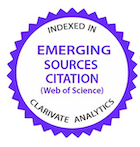Biometria do bulbo ocular de bovinos da raça Nelore
DOI:
https://doi.org/10.1590/1809-6891v15i219775Palavras-chave:
Gado Nelore, Anatomia Veterinária, Biometria ocularResumo
Objetivou-se realizar a biometria de componentes do bulbo do olho de bovinos adultos da raça Nelore. Para tal, analisaram-se 121 bulbos oculares de animais abatidos com idade entre dois a três anos em um estabelecimento no município de Itaperuna- RJ, Brasil. Vinte medições macroscópicas foram feitas nos bulbos oculares e suas estruturas. Os bulbos apresentaram eixo óptico medindo 33,27 ± 1,55 mm, diâmetro equatorial de 38,07 ± 1,70 mm e volume estimado de 24,07 ± 3,51 mL. Houve correlação moderadamente positiva (r = 0,723, p < 0,0001) entre o eixo óptico e o diâmetro do bulbo ocular na raça. A córnea de bovinos da raça Nelore demonstrou eixos vertical e horizontal comparativamente menores do que a das raças europeias citadas na literatura, porém a proporção entre a altura e a largura da córnea se manteve semelhante. A lente também apresentou dimensões menores em comparação a outras raças. Este estudo fornece dados úteis para futuras investigações clínicas das anormalidades oculares na raça Nelore bem como para pesquisas em anatomia comparada.
PALAVRAS-CHAVE: anatomia veterinária, biometria ocular, gado Nelore.
Downloads
Publicado
Como Citar
Edição
Seção
Licença
Copyright (c) 2014 Ciência Animal Brasileira / Brazilian Animal Science

Este trabalho está licenciado sob uma licença Creative Commons Attribution 4.0 International License.
Autores que publicam nesta revista concordam com os seguintes termos:
- Autores mantém os direitos autorais e concedem à revista o direito de primeira publicação, com o trabalho simultaneamente licenciado sob a Licença Creative Commons Attribution que permite o compartilhamento do trabalho com reconhecimento da autoria e publicação inicial nesta revista.
- Autores têm autorização para assumir contratos adicionais separadamente, para distribuição não-exclusiva da versão do trabalho publicada nesta revista (ex.: publicar em repositório institucional ou como capítulo de livro), com reconhecimento de autoria e publicação inicial nesta revista.
- Autores têm permissão e são estimulados a publicar e distribuir seu trabalho online (ex.: em repositórios institucionais ou na sua página pessoal) a qualquer ponto antes ou durante o processo editorial, já que isso pode gerar alterações produtivas, bem como aumentar o impacto e a citação do trabalho publicado (Veja O Efeito do Acesso Livre).






























